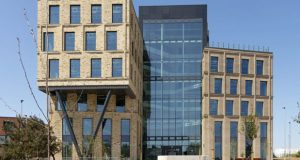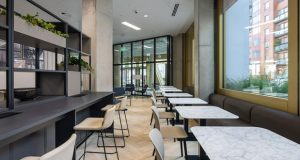Author: Richard Guy, Country Sales Manager, Ergotron UK & Ireland
With lockdown restrictions finally easing, many office workers who have been working from home are preparing to receive the call that they will soon resume working at desks they have not seen for weeks on end. While many may welcome the return to a more structured workplace environment, one thing is for sure. Organisations will need to put in place a whole new set of protocols if they are to engineer the successful return of the workforce to safe and healthy workspaces.
Keeping employees fit, engaged, and productive will be top of mind for leaders in every industry, as they prepare to initiate new workplace models. Some will be considering staggered returns, flexible hours, and shift work that is possibly spread over a seven-day week. For others, the need to limit the number of people in office spaces and preserve social distancing guidelines mean that many workers will have to alternate between office and home for weeks – perhaps months – to come.
Prioritising practical measures
Ensuring employees can work safely at an appropriate distance from one another will require a major rethink, especially for firms that use standard cube configurations or benching systems. To safely accommodate personnel, it may be necessary to initiate flexible working and hot-desking systems that will ensure personnel can stay two metres apart and limit how many people can work in the building at any one time. Which means that each desk and its accessories – phones, workstations – will need to be sanitised daily, or multiple times a day.
Shared resources, like printers and filing cabinets will also need a thorough wipe-down. As will public facilities, such as wash rooms. The provision therefore of cleaning products, sanitisers and personal protective equipment (PPE) that make it possible for employees to safely use all these facilities will be another top priority.
How employees access buildings, floors and meeting rooms will also need careful consideration. To minimise transmission, no one should touch security entry system buttons or door handles without wiping these down first. Firms will also need to think about whether they recommend that people use the stairs, rather than the lift if at all practical. It may also be safer to limit access to common shared facilities such as the cafeteria or coffee stations unless appropriate cleansing and PPE equipment can be provided at all times. Similarly, holding group meetings in conference rooms or spaces that compromise social distancing rules will also need to be avoided.
Wherever possible, implementing partitions that raise cubicle walls or create physical barriers between employees will help limit the risk of office spaces become incubators of mass infection. As will ensuring that personnel use alternate desks that can be ‘back to backed’ to limit the risk of people facing one another unnecessarily.
Finally, firms will also need to put up notices everywhere to remind employees of the importance of maintaining safe distances from colleagues, the need for regular hand washing, and any specific hygiene protocols that apply to the work areas they are entering.
Invest in flexible office furnishings
Post coronavirus, the world of office work is set to look very different indeed. But while the focus right now may be on initiating current return to work plans, business leaders should also factor in the fact that flexibility will be the key for coping with any unexpected future changes. For example, what happens if there is a second national COVID-19 outbreak.
Today’s kinetic and mobile office furnishings allow firms to repeatedly flex and reconfigure their office spaces. Enabling organisations to make the most of their existing spaces and accommodate the appropriate number of staff safely.
Plus, these furnishings also offer employees the flexibility they need to maximise their immediate working environment for their unique physiques or work tasks. Ensuring that desks, seating, and workstations are always comfortable and ergonomically matched to their height or productivity needs.
Preserving the health and wellbeing of employees
To support people as they return to work, organisations should review the social distancing recommendations that are outlined in the European Centre for Disease Prevention and Control’s recent technical report.
To reduce the risk of disease transmission and help protect employees, companies could also consider offering temperature checks before they enter the building. Thermal imaging carts are a great way to perform instant temperature checks for both employees and visitors. Other options include the provision of Perspex screens or masks or stipulating that everyone wear a face mask during office hours.
Minimising the number of unnecessary visits to offices, including customers and contractors, may also be in order. That includes requesting that ‘non-key’ staff remain working remotely for as long as possible.
Out of sight shouldn’t mean out of mind
Many employees may continue to work from home for the foreseeable future. Whether that’s because of restricted capacity at office spaces, personal health concerns, or the fact that as knowledge workers, they don’t need to take up precious office facilities to do their job.
However, working from home on a semi-permanent basis means that these employees benefit from the same duty of care as office-based workers. Couches, dining room tables, kitchen benches and beds were not designed for comfortable or safe working, so employees who are being asked to stay away from the office for the long term will need help to utilise their work technology in a safe and appropriate way.
Many organisations are now requesting that at-home employees take photos of their working area, so a health and safety assessment can be undertaken. If necessary, then appropriate desks, laptop equipment, seating and monitors that optimise user wellbeing can be sourced and provided as needed.
Safeguard your most precious resource – your people
Employees are the heart and soul of any organisation and will need to be on board with the return-to-work changes put in place in response to the easing of the current pandemic. Surveying employees for their feedback on the measures that are put in place will help empower them to shape the new working environment they’ll be expected to inhabit.
With many organisations now considering if social distancing measures will become a permanent feature of office life, getting the right equipment and procedures in place from Day One will be imperative to boosting staff motivation and performance.







